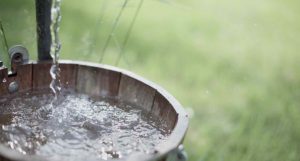
I’ve lived in Texas, Alabama, Georgia, and Missouri. In those places in the United States we had lots of rain or snow each year.
But for almost twenty years now, I’ve lived in California.
Like many places in the southwestern part of the U.S., we’re in the midst of a very bad drought. We’ve been told to severely cut back on the amount of water we use for outdoor plants, grass, and trees.
My neighbors and I love our plants, grass, and trees. They add beauty, shade, and peacefulness to our apartment buildings. So we decided to join forces to save our green spaces.
We’ve gone back in our history to find an old solution to solve a different problem: a bucket brigade, originally used to fight fires, can now be used to save water.
Several hundred years ago, “bucket brigades” consisted of two lines of people stretching from the town well to the fire. People passed buckets of water to those at the fire, and sent the empty buckets back to the well to be refilled. Later, with the invention of the hand pump, bucket brigades were used to keep the pump filled with water.
Thanks to the History of Fire-fighting article on the Merrimack (New Hampshire) Fire and Rescue website, I learned that in the early days, most fire companies were volunteer or privately operated. Fire-fighting equipment in the colonies was rudimentary at best. Leather buckets, hooks and chains, swabs, ladders, and archaic pumps were the tools of the trade in the early days.
Fire buckets in colonial towns had the owners’ names painted on them. Laws often required residents to purchase them and keep them in repair. In the 1680s in New York, the number of buckets a home or business needed was determined by the assessed fire risk. A baker was required to have three buckets on hand and a brewer had to have six in case of fire.
Firefighting finally got an edge with the invention of the hand pump, or hand tub. The foreman of each pump company would use a large “speaking trumpet” to give orders and urge his crew on.
As we know today, a bucket brigade was certainly not the best solution to fight fires back in the 1600s. But it’s the solution they had at the time. And the old technology of a bucket brigade can be put to good use in the 21st century to fight a different problem.
To save as much water as possible, my neighbors and I keep a bucket in our showers to catch the clean water that flows out while we wait for the water to get warm. We also keep one in our kitchen sinks to catch the non-soapy water from washing vegetables and fruit, or water that has been used to boil corn or steam vegetables.
This practice is allowing each of us to contribute many gallons each week to water our outdoor plants and grass and to keep a birdbath filled for our feathered and squirrel friends. We are making use of what we already have to help keep our shared green spaces alive while also adhering to water regulations. It gives us great satisfaction to know we are doing something to be the positive change we want to see.
It’s a small thing all of us can do to help conserve clean water, one of the most precious resources we have. So let’s join forces.
You can use a bucket and do the same. Even if you live somewhere that is not experiencing a drought, every drop of water everywhere is precious.
Together we can lead with our heart and use the old bucket brigade idea to help solve a different problem.

